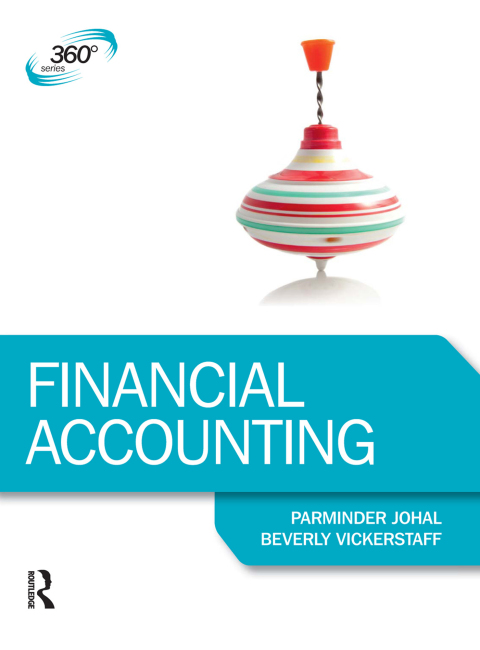Description
Efnisyfirlit
- Cover Page
- Half Title page
- Title Page
- Copyright Page
- Contents
- Acknowledgements
- Series Preface
- Preface
- Guide to the Book
- 1 Introduction to Accounting
- 1.1 Introduction
- 1.2 Accounting information systems
- 1.3 Information needs of stakeholders
- Types of stakeholders
- 1.4 Types of entity
- Sole traders
- Partnership
- Limited company
- 1.5 Legislation
- 1.6 Underlying accounting concepts
- Historical cost concept
- Money measurement concept
- Business entity concept
- Time interval concept
- 1.7 Fundamental accounting concepts
- Going concern
- Accruals (matching) concept
- Consistency
- Prudence
- Substance over form
- Materiality
- 1.8 The statement of principles
- 1.9 Audit and corporate governance
- External audit
- Internal audit
- 1.10 Summary
- Recommended reading
- Useful websites
- 2 Recording transactions
- 2.1 Introduction
- 2.2 The accounting equation
- Worked Example
- 2.3 T-accounts, debits and credits
- Worked Example
- 2.4 Balancing the accounts
- Worked Example
- 2.5 The trial balance
- Worked Example
- 2.6 More T-accounts
- Worked Example
- 2.7 Summary
- Recommended reading
- 3 The Statement of Financial Position
- 3.1 Introduction
- 3.2 The basic statement of financial position
- 3.3 Understanding the terminology
- 3.4 The accounting equation
- 3.5 Preparing a statement of financial position
- 3.6 Company statements of financial position
- 3.7 Published statements of financial position
- 3.8 Limitations of the statement of financial position
- 3.9 Summary
- Reference
- Recommended reading
- Useful websites
- 4 The income statement
- 4.1 Introduction
- 4.2 The basic Income statement
- 4.3 Understanding the terminology
- 4.4 Preparing an Income statement
- Worked Example
- Worked Example
- Worked Example
- 4.5 Service organizations
- 4.6 Company income statements
- Worked Example
- 4.7 Published income statements
- 4.8 Limitations of the income statement
- 4.9 Summary
- Reference
- Recommended reading
- Useful websites
- 5 Current assets: Valuation of inventory, bad debts and bank reconciliations
- 5.1 Introduction
- 5.2 Inventory
- Valuing inventory in the financial statements
- The cost of inventory
- Different assumptions in costing raw materials
- 5.3 Receivables
- Bad debts
- Doubtful debts
- General provisions for doubtful debts
- Receivables in published accounts
- 5.4 Bank
- Bank reconciliations
- The importance of bank reconciliation
- Manipulation of the bank figure in the financial statements
- 5.5 Summary
- Recommended reading
- Useful websites
- 6 Adjustments to accounts I: Accruals and prepayments
- 6.1 Introduction
- Cash versus accrual
- 6.2 What is an accrual?
- 6.3 Accounting treatment for accruals
- 6.4 What is a prepayment?
- 6.5 Accounting treatment for a prepayment
- 6.6 Relating accruals and prepayments to real company accounts
- 6.7 Summary
- Recommended reading
- Useful websites
- 7 Ajustments to accounts II: Non-current assets and depreciation
- 7.1 Introduction
- 7.2 Valuing non-current assets on the Statement of Financial Position
- 7.3 Depreciation
- 7.4 Calculating depreciation
- The straight line method
- Reducing balance method
- When should each method of depreciation be used?
- 7.5 Accounting for the sale of a non-current asset
- Calculating the gain or loss on the sale of a non-current asset
- Relating depreciation to real company accounts
- 7.6 Summary
- Recommended reading
- Useful websites
- 8 Cash flow statements
- 8.1 Introduction
- 8.2 The importance of cash
- 8.3 Cash versus profit
- Timing differences
- Depreciation
- Changes in the working capital requirements
- 8.4 The purpose of the cash flow statement
- 8.5 Presentation of the cash flow statement
- Cash flows from operating activities
- Cash flows from investing activities
- Cash flows from financing activities
- 8.6 Interpreting cash flow statements
- Is the company able to pay a dividend?
- What Is the level of spending on non-current assets?
- Has the company raised new finance?
- Why Is the company showing a negative cash flow from operating activities?
- 8.7 Cash flow budgets
- 8.8 Summary
- Recommended reading
- 9 Interpretation of accounts
- 9.1 Introduction
- 9.2 Users of financial statements
- 9.3 The interpretation process
- 9.4 Ratio analysis
- 9.5 Interpreting published financial statements
- Notes to the accounts
- Gross profit percentage (GP%)
- Net (operating) profit percentage (NP%)
- Return on capital employed (ROCE)
- Current ratio
- Quick ratio
- Asset turnover
- Inventory turnover period
- Trade receivables turnover period
- Trade payables turnover period
- Investment ratios
- Earnings per share (EPS)
- Dividend cover
- Price/earnings ratio (P/E ratio)
- Market capitalization
- 9.6 Other analytical measures
- 9.7 Limitations of ratio analysis
- 9.8 Summary
- References
- Recommended reading
- Useful websites
- Glossary of Terms
- Answers to Questions
- Chapter 1
- Reflective questions
- Activity
- Review questions
- Chapter 2
- Reflective questions
- Activity
- Review questions
- Chapter 3
- Reflective questions
- Activity
- Review questions
- Chapter 4
- Reflective questions
- Activity
- Review questions
- Chapter 5
- Activity
- Review questions
- Key Themes
- Case studies
- Chapter 6
- Reflective questions
- Activity
- Review questions
- Chapter 7
- Reflective questions
- Activity
- Review questions
- Key Themes
- Case Study
- Chapter 8
- Reflective questions
- Activity
- Review questions
- Key Themes
- Case Study
- Chapter 9
- Reflective questions
- Activities
- Review questions
- Case study
- Index






Reviews
There are no reviews yet.